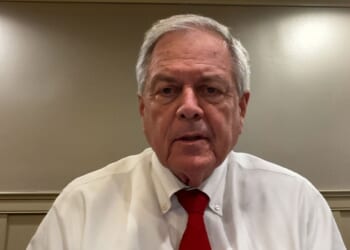After a resounding 99-1 defeat last summer, efforts to enact an artificial intelligence moratorium are back, this time with a push to force it into the National Defense Authorization Act (NDAA).
As Annie Chestnut Tutor notes, supporters say it is needed to stop “an unworkable patchwork of disparate and conflicting state AI laws” and to protect America’s lead over China. Yet the moratorium would undermine that very goal.
America is poised to lead the world in AI-enabled biotechnology, and the best way to secure that lead is through federal-state partnerships, where states pilot clinical AI rules, accelerate safe deployment, and pressure federal agencies to modernize faster than any single national bureaucracy could on its own. America needs an AI framework that channels innovation toward human flourishing and sets limits on projects that fail to serve that goal, as states already do through age-verification pornography laws and AI chatbot protections for kids. For all its promises, a moratorium proposal in the NDAA would likely miss these marks.
In practice, a federal moratorium would not simply “pause” regulation in the abstract—it would freeze state enforcement authority over the fastest-moving and most ethically sensitive AI applications in medicine and biotechnology. States would be barred from updating medical AI standards, restricting embryo-scoring algorithms, regulating clinical decision software, or enforcing emerging protections for children and patients. This would create a regulatory vacuum precisely where AI is advancing fastest, leaving life-altering technologies governed by corporate policy rather than public law.
Some of the most promising near-term benefits of AI lie in biotechnology, especially in health and infertility diagnostics.
President Donald Trump has been clear on this point. Earlier this week, he released a fact sheet on “The Genesis Mission to Accelerate AI for Scientific Discovery,” which establishes a national initiative to unify federal data, computing power, and scientific expertise. Two months ago, he issued an executive order aimed at using AI to unlock cures for pediatric cancer through the expanded Childhood Cancer Data Initiative. These actions recognize the power of large computation tools to break through scientific stagnation and spark a fresh era of medical discovery.
Proponents of a moratorium argue that without uniform national rules, a patchwork of state laws will throttle the AI industry through burdensome compliance costs, regulatory gaps, and legal uncertainty. In the short term, a moratorium would reduce some of that friction by removing requirements or postponing new regulatory obligations. But it does not resolve the underlying conflicts; it merely postpones their resolution while eliminating the very state-level experimentation that has historically produced workable national standards. Uniformity achieved by freezing governance is not leadership; it is paralysis.
AI-driven diagnostics hold particular promise. They can scan vast medical datasets and spot patterns that clinicians miss, giving patients earlier detection and more tailored care for infertility, rare diseases, and hard-to-diagnose conditions. Today, as many as 30% of infertility cases are labeled “unexplained.” Larger datasets and AI analysis tools could drastically improve diagnostics. At the same time, smarter algorithms could guide personalized treatments that restore health and give families hope. These are life-affirming, restorative uses of AI that deserve support.
Yet every advance carries risks. AI-powered systems can misdiagnose. They can introduce bias. They can create black-box recommendations that further alienate the patient and clinician alike. And in reproductive medicine, these tools are already being used in ways that steer us toward a consumer-driven form of eugenics. Clinics now use software to grade and rank embryos. Companies market polygenic scoring tools that claim to forecast not only disease risks but also personality traits or cognitive outcomes. A blanket moratorium on AI regulation would directly undermine legitimate state efforts to prevent AI from being used to commodify human life.
The lesson from recent technological history bears this out. Take the rise of sex-rejecting transgender surgeries. Medical advances made them possible, but Americans now recognize the deep harm they have caused, especially to children. Higher rates of suicide, depression, infertility, and regret underline that not every innovation is a step forward.
The same pattern occurs with non-human research, too. AI tools can now generate new genomic sequences in microbes and viruses. This opens the door to new treatments in non-human specimens, but the same technology could also accelerate the creation of smart bioweapons that target particular countries or demographics. Research labs around the country are deploying systems that grow cells into organoids and run self-driving laboratories that complete thousands of experiments each week. Some of these platforms even advertise that “tech expertise is not required.” That should concern us. As these systems grow more complex and as human oversight shrinks, researchers may lose the ability to fully understand or interpret what these AI-run machines are producing.
These breakthroughs are not only scientific. They reshape culture and politics. As philosopher Marshall McLuhan argued, we must judge technology not only by what it does but by what it does to us. It changes relationships. It shifts power. It affects the core structures of family and community. The states are where technology, people, and policy first intersect. That is why our national AI strategy ought not to deny their role to guide innovation toward life-giving, human-centered, and restorative ends.
Our service members deserve a swift resolution to the NDAA. They also deserve policy that strengthens American innovation toward human flourishing. A moratorium on artificial intelligence would do the opposite. It would weaken public oversight and freeze state protections at the very moment we need thoughtful, principled, and purpose-driven policy to govern these tools, especially as they shape the creation, selection, and development of human life.

















